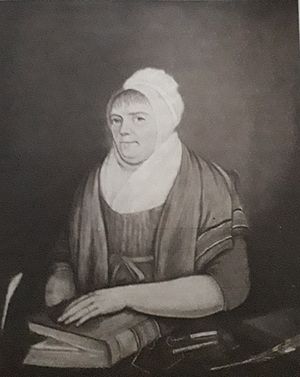Elizabeth Beecroft facts for kids
Elizabeth "Betty" Beecroft (1748–1812) was a very important manager at Kirkstall forge. From 1778 to 1785, she helped make and sell iron and iron products. A forge is a place where metal is heated and shaped.
Betty's Early Life
Betty was born in 1748 in a place called Clifton, near Otley. Her father, John Skirrow, worked with animal hides as a tanner. Her mother sold butter. Betty was one of eleven children, but only six lived to be adults.
Even though her father spent money easily, Betty's mother made sure all the children got a basic education. When Betty was 18, she started her own business. She sold pots, glasses, and china with her brother James. She also sold butter twice a week at the Leeds market.
On March 28, 1775, Betty married George Beecroft, a farmer from Bramley. The Beecroft family were followers of John Wesley, a famous religious leader. Betty and George lived on a farm called Kepstorn, close to Kirkstall Forge.
Managing the Forge
In October 1778, Betty had a big idea. She suggested to her husband that they should rent the Kirkstall forge, along with its farm and mill. Her husband, George, was worried about such a big project.
But Betty was determined! She worked with her mother-in-law and her brothers-in-law, John and Thomas Butler, to get the lease. They also helped find the money needed to run the forge. Thomas Butler gave £1000, and Betty and George managed to raise £800. It was Betty's bravery and ambition that made this family business happen.
While George took care of the farm and mill, Betty managed the forge's business side. She handled the money, bought materials like scrap metal, and hired workers. After the first year, John Butler became more involved. He visited weekly to pay wages and manage orders.
Betty's money management skills were excellent. The forge made great profits. In 1780, it earned £172. By 1784, this had grown to £952!
In 1785, John Butler built a house at the forge and took over the main management from Betty. Betty was happy about this because she found John's management style difficult. However, after nine months, John asked Betty to return to the account books. He knew she was very clever with business. She continued to work there until 1805.
A famous preacher, John Wesley, once stayed with Betty and George. He took shelter with them after a crowd chased him out of Horsforth.
Later Life and Legacy
Even after she stopped working at the forge, Betty continued to manage the farm's butter business. She sold butter in Leeds and Otley.
In 1793, during a war between England and France, Betty was wrongly accused. People said she was selling butter and bacon to France. Betty quickly published a notice in the Leeds Mercury newspaper on May 4, 1793. She denied the accusations and offered a reward of 10 guineas for information about who was spreading these false rumors.
Betty Beecroft passed away in 1812. A minister named Mr. Robert Wood spoke about her. He said she was very hardworking, careful with money, and had a strong mind. He also said she was very dedicated to her religious beliefs.
Betty's daughter, Anne, later married Thomas Butler, who was the son of John Butler. This Thomas Butler was a diarist and eventually took over the management of the forge.
Betty wrote her own life story, called memoirs. Parts of her memoirs have been published. They tell about her family's spiritual experiences with preachers in Leeds. Betty also wrote about how she learned from a kind widow named Effem Banks. Effem Banks welcomed many preachers and strangers into her home.
Betty was featured in an exhibition called Leeds to Innovation. This exhibition was held at the Leeds Industrial Museum at Armley Mills from October 2019 to September 2020. A local artist named Ping Kelly even painted a portrait of Betty for the exhibition.


